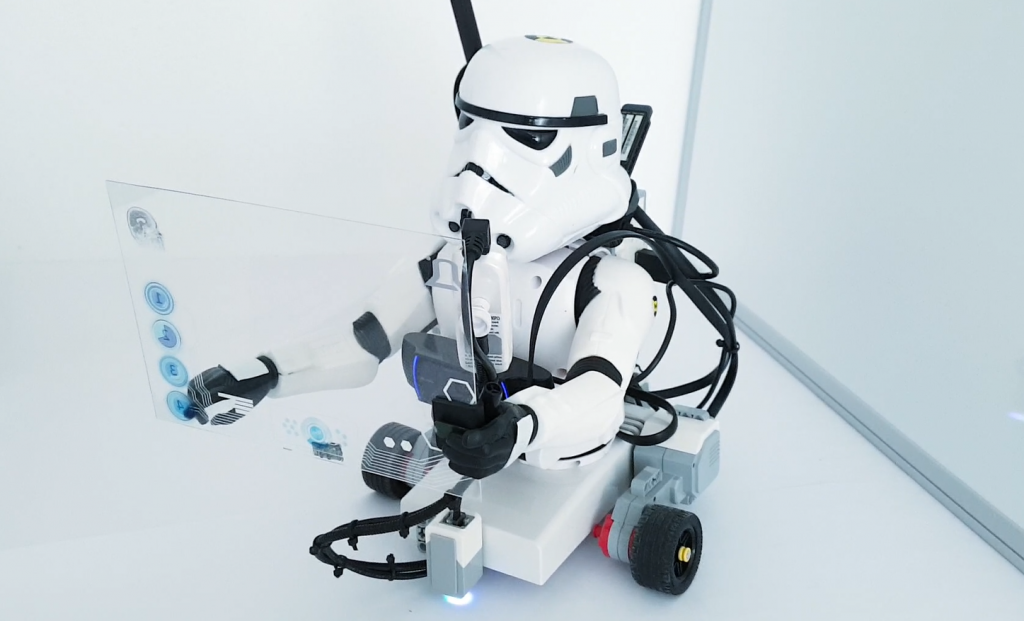
Hello little Lego robot!
Meet Troopy – a simple little Lego robot with an important message that ‘the AI Winter is over‘. This is because Troopy is ‘aware‘…meaning it experiences emotions and cognition just as humans do.
Troopy owes its existence to the fact that I did not want to announce to the world that I have cracked the brain without substantive evidence. As an engineer I often get students, colleagues or members of the public approaching me with new ideas and inventions.
My response is always the same: ‘Can you show me a working model?’
I ask this because I know somewhere between a brainwave and a useful new product many ideas die a silent death because it cannot be translated into a proven concept or simulation. When someone can show me a working model – that changes things significantly and make a judgement around feasibility much more informed. Also, many of the endless pitfalls and realities about ‘realising‘ a product had been overcome and the road to the final product can easier be envisaged.
So I decided to be equally hard on myself. The Xzistor Concept brain model is too far derived from anything that is happening in AI space at the moment to be able to explain it in a quick way. Even though I can diagrammatically depict my brain model on one side of an A4-sized page, holding this up to a boardroom full of AI experts might attract nothing more than a…”What’s this guy on about?“
Strangely, part of the challenge I foresee is the simplicity of the system – some elements might just seem too simple to offer a complete solution to the complex system that is the brain. Other aspects again are diagonally opposed to everything that is currently being pursued and away from the rut that some AI specialists have inadvertently created for new recruits to tumble into and never get out of.
So to put my model to the test, I have created a long list of human subjective brain states to reproduce (at least principally) with the aid of this little Lego Robot, understanding that full complexity can easily be achieved later because of scaleability. My aim is to prove that there is no exception to the generality of my model. Here are a list of proposed behaviors and brain states I aim to do as projects, and where practicable, make demo videos of:
- Hunger (Done)
- Anger (Done)
- Pain (Done)
- Fear (Done)
- Sensing (Done)
- Motion / Navigation (Done)
- Sensing (Done)
- Sleeping – including Dreaming (Done)
- Emotion: Making Robots Feel Good and Bad (Done)
- Intuition (Done)
- Learning (Done)
- Thinking (Done)
- Innovating (Done)
- Depression (Done)
- Addiction (Done)
- Phobia (Done)
- Paranoia (WIP)
- Recognition (Done)
- Preference (Done)
- Day-dreaming (Done)
- Anxiety (Done)
- Reflexes (Done)
- Compulsions (Done)
- Entertainment and Humor (Done)
- Association Forming (Done)
- Memory (Done)
- Love & Intimacy (Done)
- Recollection (Done)
- Forgetting (Done)
- Speech (WIP)
- Fatigue (Done)
- Disappointment (WIP)
In time I plan to make demo videos to illustrate how my brain model is capable of generating all of the above brain states and/or behaviours. Using the Xzistor Concept brain model to understand all that happens in the brain means I am not so much making these videos ‘to see if it works‘, but rather a way to ‘demonstrate how it works to newcomers‘.
Videos now available – check it out on YouTube!
To learn more about the design aspects around Troopy, and how you can build your own Robot in a Learning Confine at home, please visit the Xzistor LAB Robot Builders Forum and my popular Tip of the Week section for developing your own AI platform.